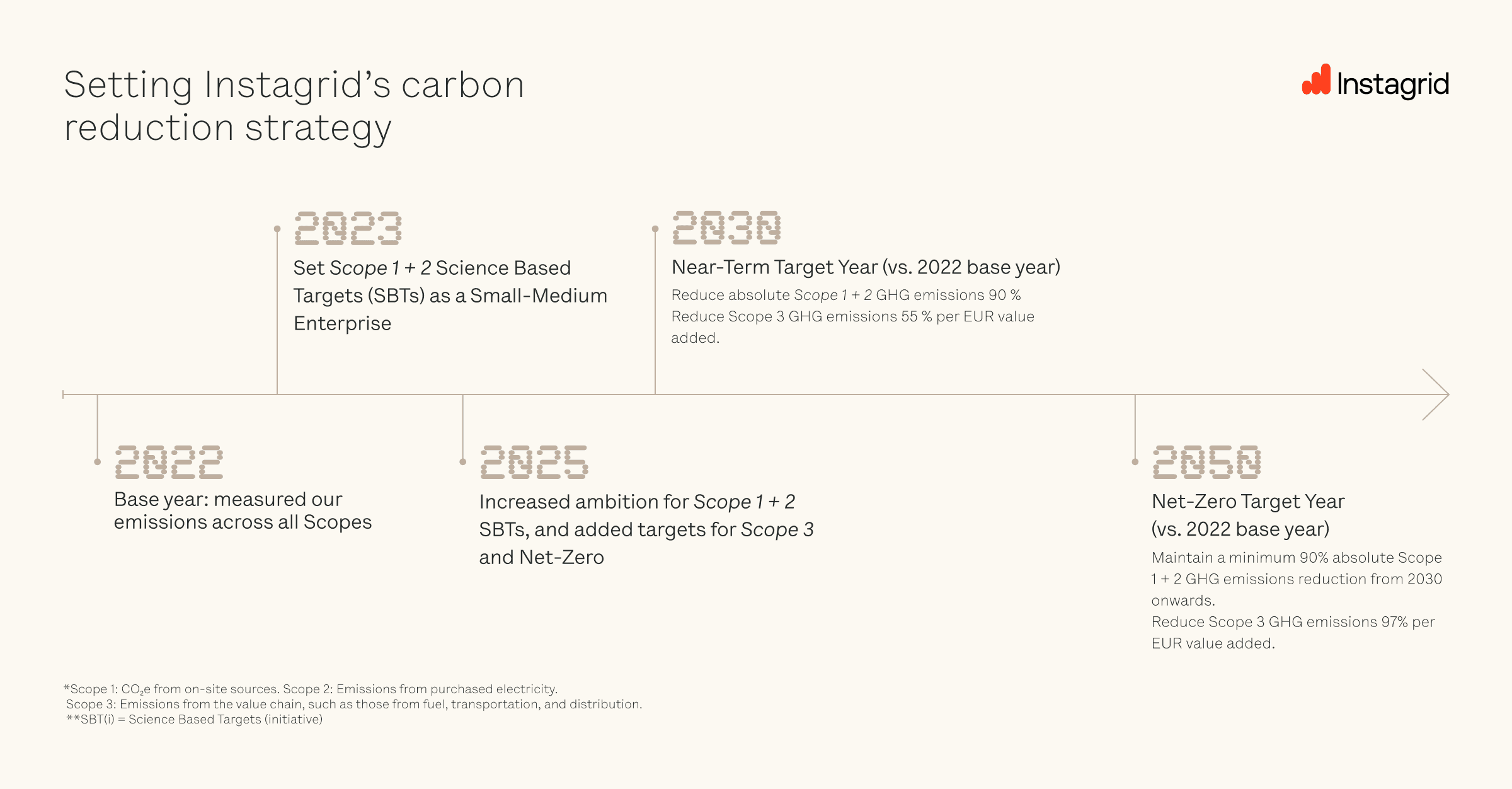As COP30 in Belém, Brazil comes to an end, it is evident that the 1.5 °C target is no longer within reach. Under current policies, global warming is projected to reach around 2.3 °C to 2.8 °C this century. What this means: the call is not just for promises, but for deep, immediate action — and for plans that expect and address overshoot, not assume it will be avoided.
At Instagrid, we have long been committed to the Science Based Targets initiative (SBTi). In response to accelerating climate urgency, we have further elevated our targets, going beyond baseline ambitions to ensure our roadmap aligns with the pace and scale the climate crisis demands.
Our ESG Team plays a central role — producing our type: entry-hyperlink id: 3PphwS16EeattplEfJag8K, and partnering directly with customers to provide TCO (Total Cost of Ownership) models, fleet emissions analyses, and actionable insights. We believe that deploying clean power is essential, but enabling measurable decarbonisation across value chains is where real leadership lies.
Our Journey and Ambitious Targets
We have set SBTi-aligned targets mapping our course to 2030. Already midway, we’ve further intensified our commitments, recognizing that decarbonisation demands dynamic ambition, not static goals.
By 2030:
Reduce absolute Scope 1 & 2 emissions by 90 % (vs. 2022 baseline).
Reduce Scope 3 emissions intensity across our full value chain (per EUR value added) by 55 % (vs. 2022 baseline).
Ensure that all new products from 2026 onward integrate full life-cycle decarbonisation thinking – from material sourcing to end-of-life recycling.
By 2050 (or earlier):
Maintain a minimum 90 % absolute Scope 1 and 2 GHG emissions reduction from 2030 through 2050 (vs. 2022 baseline).
Reduce Scope 3 GHG emissions intensity (per EUR value added) by 97 % (vs. 2022 baseline).
Achieve net-zero emissions across our entire value chain, in line with the SBTi Corporate Net-Zero Standard.
Use carbon removals only for residual, hard-to-abate emissions – always prioritising reduction over offsetting.
We set these targets not just for ourselves, but to walk the same journey with our customers.
Rental Customers Leading the Way
Across Europe and beyond, rental companies are leading the transition to low-carbon operations, setting new benchmarks for the industry.
Kiloutou Group, with its SBTi-validated targets to cut Scopes 1 & 2 emissions by 42 % and Scope 3 by 25 % by 2030, is a pioneer in the transition. As Audrey Miclard, Sustainability Manager, explains:
“Instagrid isn’t just a mobile energy supplier — it’s a strategic partner helping us measure and reduce our environmental impact. Thanks to their solutions, we’re accelerating our transition.”
Sunbelt Rentals, one of the world’s largest rental companies, shares the same forward momentum. Andy Webb, National Sales Director at Sunbelt Rentals UK & Ireland, noted:
“(…) By becoming the UK’s largest supplier of Instagrid, we’re making sustainable power solutions more accessible to our customers and helping them easily make the switch to low and zero emission technology.”
LoxamHune, part of the Loxam Group is one of Spain’s industry leaders embracing battery technology. Recognising the need for sustainable, customer-centric solutions, the company has integrated a range of battery-based systems into its rental portfolio. This new addition aligns with its sustainability strategy, which includes a specialised low-carbon equipment range called LOXGREEN. LoxamHune is also the first company in its sector in Spain registered with the Ministry for the Ecological Transition and the Demographic Challenge, having achieved Climate-Neutral Company status.
Speedy Hire, another UK rental company to invest in Instagrid units, is the first in the UK hire market to achieve SBTi validation under the NetZero Standard. Their targets: Scope 1 & 2 reductions of 51.6 % by 2030, Scope 3 reduction of 42 % by 2030, and net-zero by 2040. They further articulate how they are helping customers through “Net Zero Hire” services and investment in electric fleets and low carbon equipment.
Together, these customers demonstrate how the rental sector is driving measurable progress, embedding sustainability and SBTi reporting into core business strategies. This shift signals a broader transformation: customers aren’t just renting equipment – they are renting decarbonisation outcomes.
Leading by Example
Every Instagrid system replaces a fossil-fuel generator, reducing life-cycle emissions by up to 94%. Together with our customers, we’ve already helped avoid significant volumes of CO₂e emissions. Through close ESG collaboration, lifecycle design, and transparent reporting, we ensure every partnership contributes to meaningful, verifiable carbon reduction.
From COP30 to 2030: Acting Together
COP30 marks a turning point — from commitments to measurable implementation. Instagrid’s enhanced SBTi targets are a reflection of that urgency and our conviction that climate action must be shared.
While many smaller battery companies have yet to take this step, we’re not waiting. We’ve chosen to act decisively — setting ambitious, science-based goals, and working side by side with our customers to accelerate the transition to clean, portable power.
Find out more about Instagrid's targets: Target dashboard - Science Based Targets Initiative
